ZEN ZEBRAS
ADDITION STRATEGY: BREAK APART ONE ADDEND
Dive into this 5-Day Problem Based Math Unit which focused on the efficient strategy of breaking apart one addend to add values within 50
Intentionality
Spark Curiosity
Fuel Sensemaking
During Moves
Student Approaches
Next Moves
Consolidation
Reflect and Consolidation Prompts
Resources & Downloads
Educator Discussion Area
Intentionality & Unit Overview
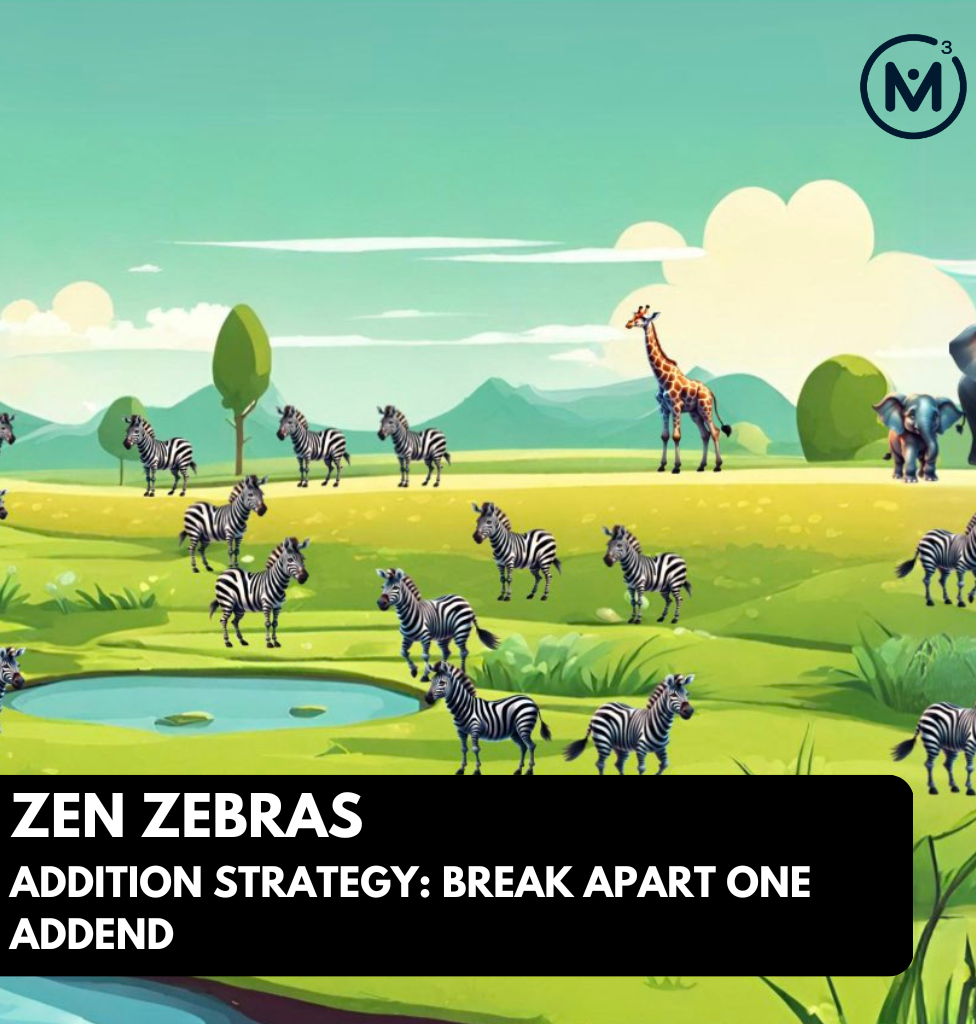
Length of Unit: 5 Days
Access each lesson from this unit using the navigation links below
Students will explore addition in a context encouraging students to use a strategy that allows them to flexibly work with the addend by decomposing it.
A connection can be made to the combinations that make ten.
Intentionality…
In this task, students will engage in a subtraction context and lead towards a strategy of decomposing the subtrahend.
Some of the big ideas that may emerge through this task include:
- Understanding hierarchical inclusion allows for flexible composing and decomposing of numbers
- Numbers can be decomposed by separating a whole into two or more parts
- Addition names the whole in terms of the parts
- Different addition situations will elicit different strategies
- Number relationships provide the foundation for strategies to help students remember basic facts
- Models can be used to connect concrete to abstract
Before starting this unit, students should be familiar with:
- Facts of 10 ( e.g., 6 + 4 = 10, 10 – 4 = 6)
- Flexibility when decomposing numbers (e.g., 13 can be decomposed into 10 and 3, but also 9 and 4, 8 and 5, etc)
The Up and Over Ten strategy which can be explored in the Bowling Pins Unit.
Spark Curiosity
What Do You Notice? What Do You Wonder?
Show students the following video:
Then, ask students:
What do you notice?
What do you wonder?

Give students about 30-60 seconds to do a rapid write on a piece of paper or silent individual think time.
Replaying the video can be helpful here if appropriate. Ensure that students do not long enough to 1:1 count each Zebras. This will encourage some subitizing to occur and for students to visual what they saw.
Then, ask students to pair share with their neighbors for another 60 seconds.
Finally, allow students to individually share with the entire group. Be sure to write down these noticings and wonderings on the blackboard/whiteboard, chart paper, or some other way that is visible to all. This helps students to see the thinking of their classmates and ensures each student that their voice is acknowledged and appreciated. Adding student names or initials next to their notice/wonder is one way to acknowledge their participation and can motivate others to join in.
Some of the noticing and wondering may include:
- I notice that they are in a savannah/safari
- I notice there are a lot of zebras
- I notice that there are elephants in the background
- I wonder if there are any lions around
- I wonder how many zebra there are
Estimation: Prompt
After we have heard students and demonstrated that we value their voice, we can ask the estimation question. The students may have already made some guesses of the amount of Zebras in the previous section. The students will feel value as you now ask them to make a true estimation.
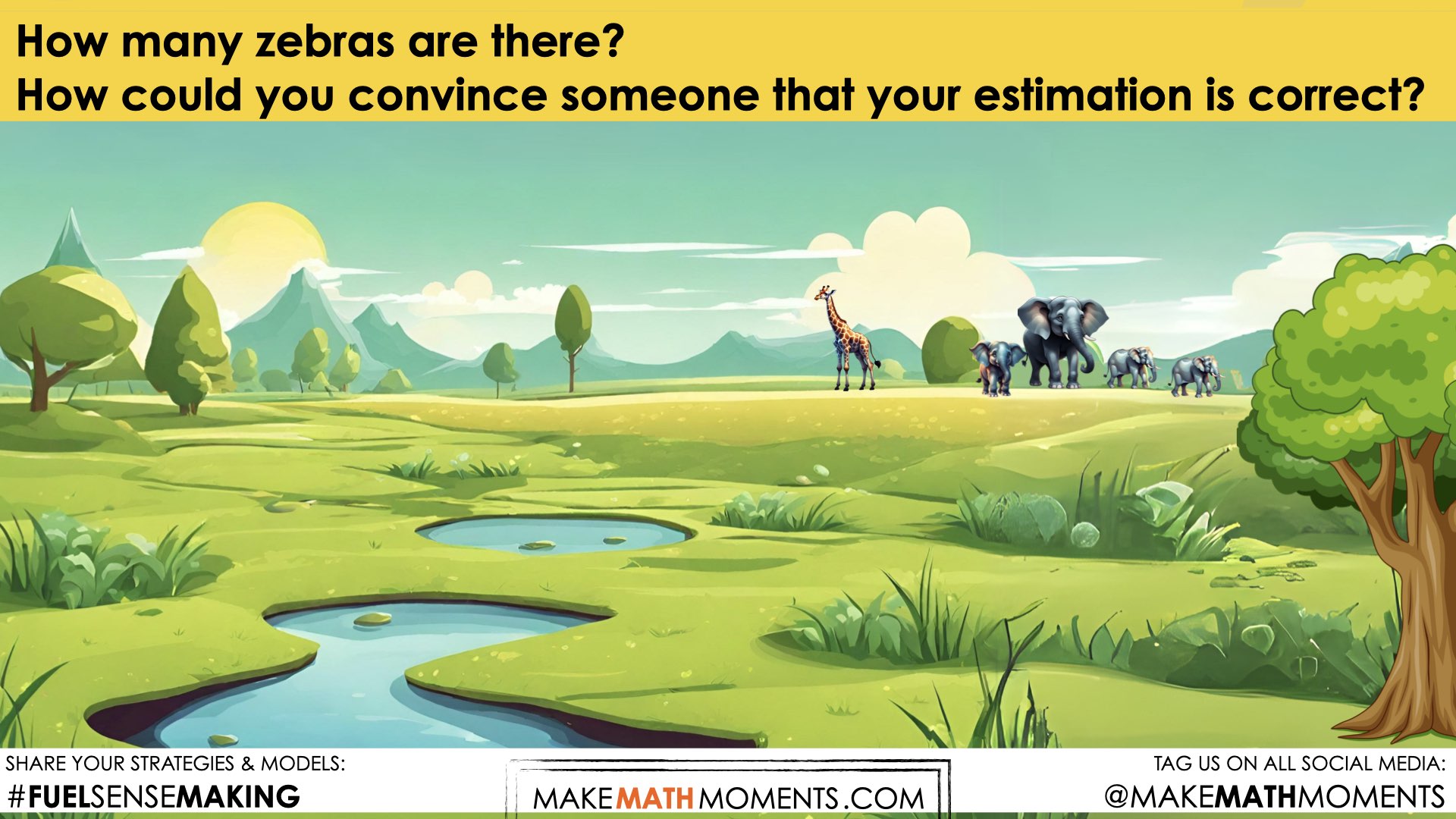
How many zebras are there?
Follow up that question with:
How could you convince someone that your estimation is correct?
We can now ask students to make an estimate (not a guess) as we want them to be as strategic as they can possibly be. This will force them to use spatial reasoning such as the amount of Zebras in a small group to help justify how many there are overall. Before collecting student estimates, students can share their estimates with neighbouring students along with the reasonings.
Consider asking students to think about a number that would be “too low” and a number that would be “too high” before asking for their best estimate in order to help them come up with a more reasonable estimate.
While Students are Estimating:
Monitor student thinking by circulating around the room and listening to the mathematical discourse. You may identify some students whose thinking would be valuable to share when the group’s estimates are collected.
Encourage students to make estimations rather than 1:1 counting each Zebras. The video may be paused for longer before it goes blank but we want students to make estimations based on their mathematical understanding and spatial sense.
Similar to collecting their noticings and wonderings, collect students’ range of estimates and/or best estimates along with initials or names. Having some students share justifications is an opportunity for rich, mathematical discourse.
Estimation: Reveal
Share the following animation.
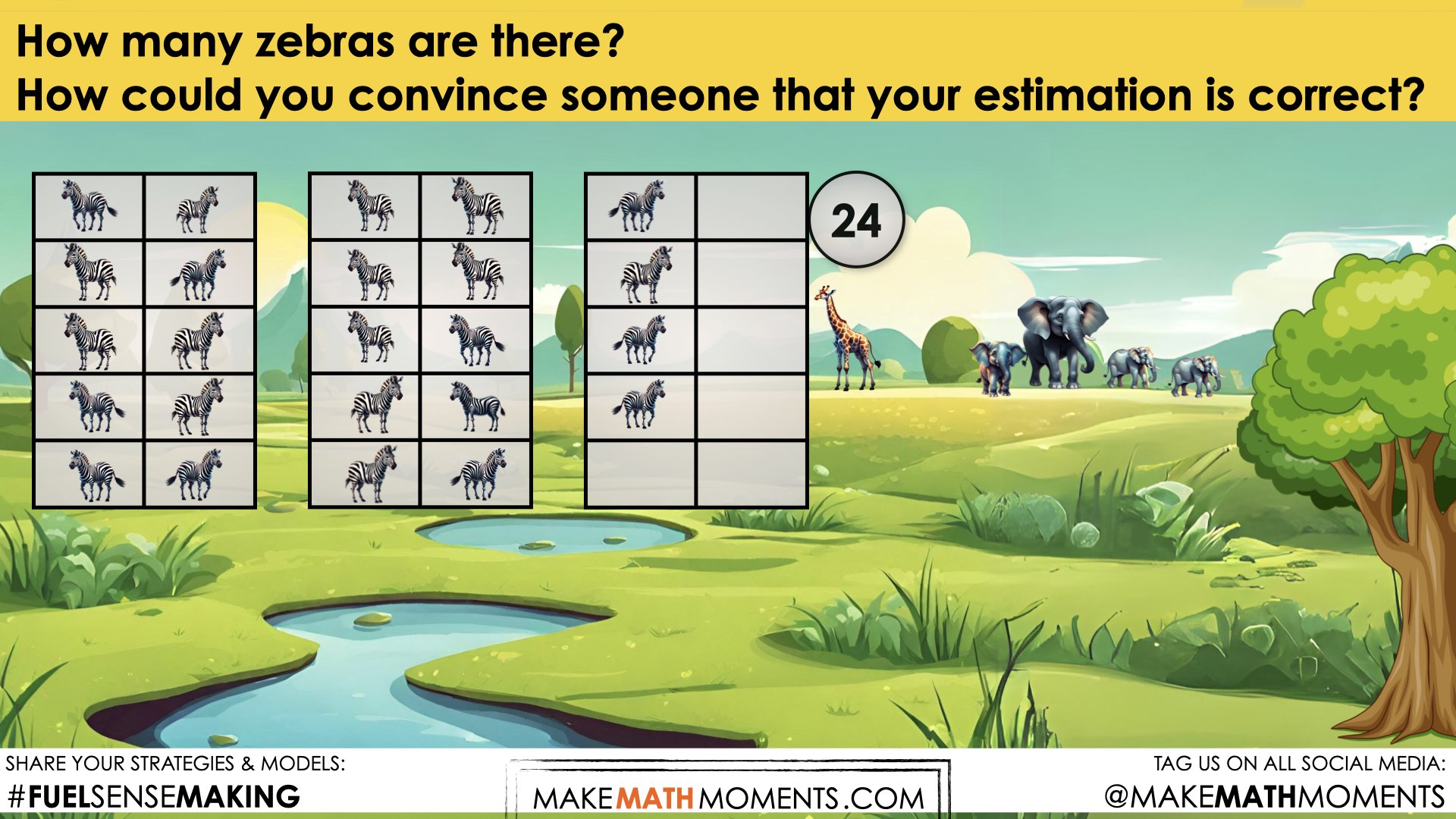
Celebrate students who estimated closest to 24 zebras
Fuel Sense-making
Crafting A Productive Struggle: Prompt
Since you have already taken some time to set the context for this problem and student curiosity is already sparked, we have them in a perfect spot to help push their thinking further and fuel sense making.
Share the following video with the prompt.
Eight zebras wander up to get a drink from the watering hole. How many zebras are there now? How do you know?
Facilitator Note: The students will need to use the answer 24 from the estimation prompt. If the estimation prompt was not explored before the struggle prompt, perhaps take a moment to do that or point out the 24 above the trees in the struggle prompt.
The zebras were purposefully appearing on the screen in a 6 + 2 pattern to make up the 8 more zebras. This will ideally lead to a discussion about decomposing 8 into easier pieces to work with.
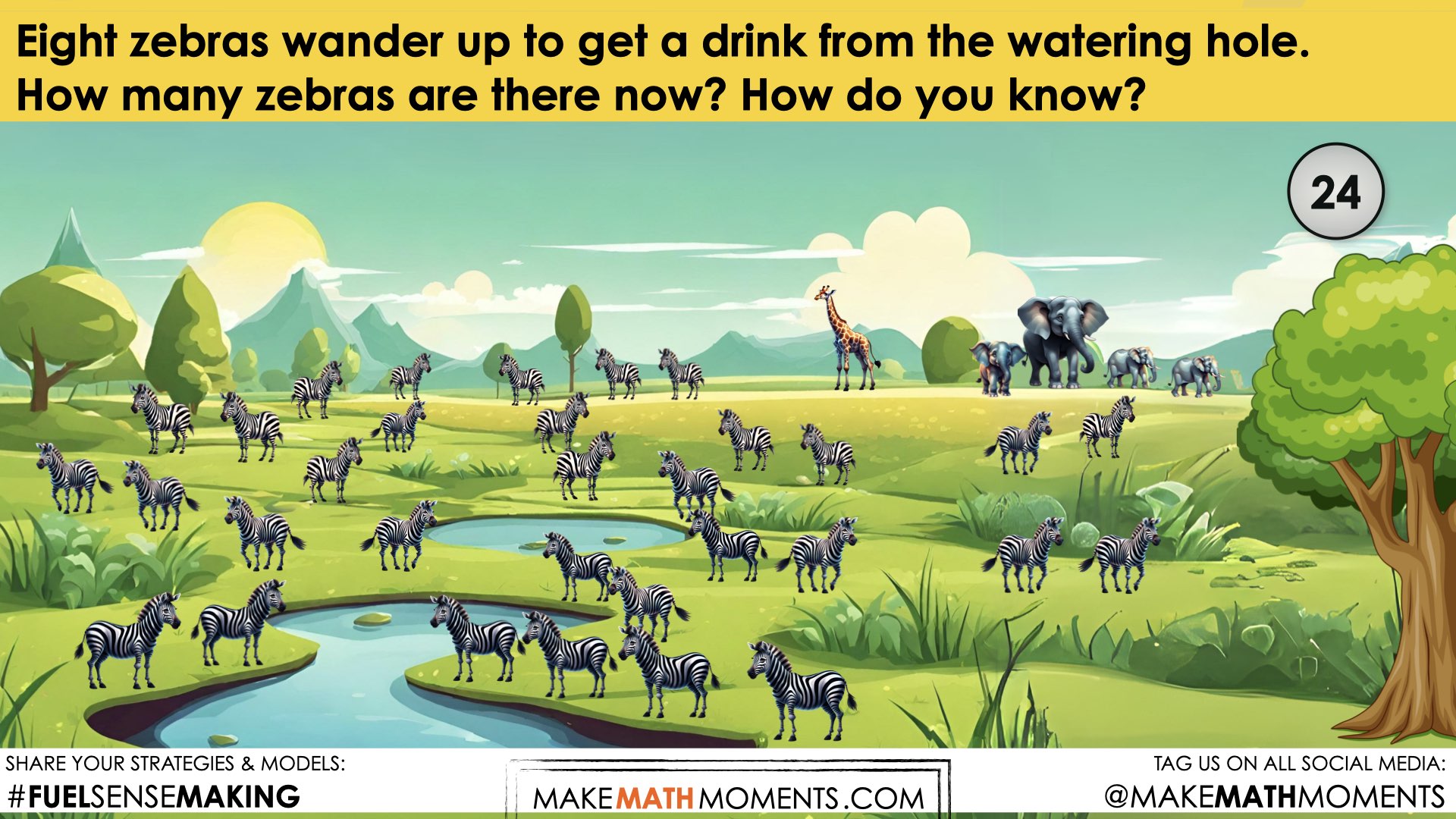
During Moves
While Students Are Productively Struggling…
Monitor student thinking by circulating around the room and listening to the mathematical discourse. Educators are looking for students that are making their thinking visible so it can be displayed during consolidation. Select and sequence some of the student solution strategies and ask a student from the selected groups to share with the class from:
- most accessible to least accessible solution strategies and representations;
- most common misconceptions;
- most common/frequent to least common/frequent representations; or,
- choose another approach to selecting and sequencing student work.
The strategies you might see students use include:
- Direct Modeling and counting all
- Counting on
- Breaking up the 8 into 6 and 2 (Adding 6 to 24 to make 30 then adding the remaining 2 to make 32).
Assessment:
This checklist can be used for tracking formative assessment as students are working. The information collected can be used to form whole group, small group or one-to-one support models.
Early Strategy | Direct modeling and counting all | Students will count the initial value, count the amount added then count all of the amounts. Example: Count 1: 6 bowling pins Count 2: 4 bowling pins blocks Count 3: 6 bowling pins and the 4 bowling pins to know 10 bowling pins in all |
Count On | Students are holding one number in their head and continuing to count forward and track their count | |
Decompose Numbers (Part/Part Whole) | ||
Facts of 10 | Student can automatically recall a matching combination of 10 | |
Adding onto 10 (teen numbers) | Students recognize that when adding a single digit onto 10, it will become one of the teen numbers. This should be an automatic understanding. | |
Up and Over 10 | Students decompose one of the addends to make 10. This is a “friendly” number to stop at. Then they use the other part of the addend and add onto 10. They are going up to 10 and then over it. E.g. 8 + 6 6 can be decomposed into 2 and 4. 8 + 2 = 10 Use the remaining part of 6 (4) and add it onto 10. 10 + 4 = 14 Therefore 8 + 6 = 14 | |
Break apart one number into easier pieces | Similar to Up and Over Ten, this strategy extends beyond the teen numbers though. One of the numbers (ideally the smaller number) is broken into parts (decomposed) that will make it easier to add. E.g. 34 + 18 We would keep 34 whole and decompose 18. The decomposition is not random. We want students to work with decade numbers and add on. 6 can be decomposed from 18 34 + 6 = 40. By getting our number to 40, we have made it easier to add on the remaining parts. Students may be able to add on the remaining 12 from the 18 in one move or they may choose to decompose 12 as well. Regardless, we want to eliminate the counting on strategy and instead start working with numbers. 40 + 12 = 52 Therefore 34 + 18 = 52. | |
Student Approaches
Student Approach #1: Counting All with a Tool
I counted out 24 blocks for the 24 zebras. 
Then I counted 8 more blocks and put them together. I counted all of the blocks and there were 32. So there are 32 zebras.
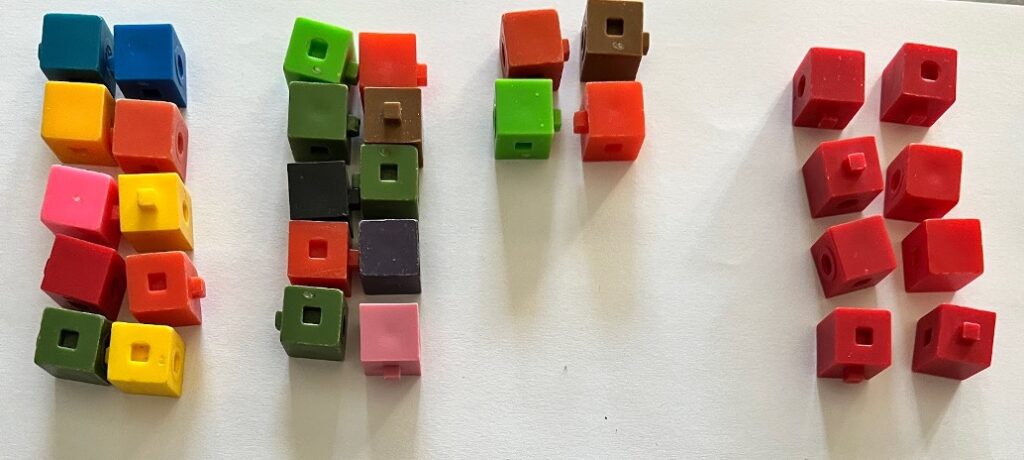
Student Approach #2: Counting All with a Drawing
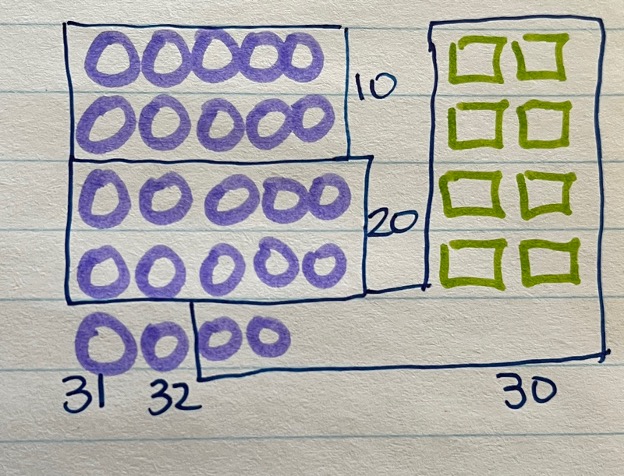
I drew 24 circles for the 24 zebras. I drew 8 more circles then counted them all. There were 32 circles which made 32 zebras.
Student Approach #3: Counting On

I kept 24 in my head and used my fingers to count on 8 more.
Student Approach #4: Breaking Apart the Subtrahend

I added 6 to 24 to get to a friendlier number/decade number (30). Then I only had to add on 2 more to get 32.
Next Moves
Reveal
Show students the following reveal video: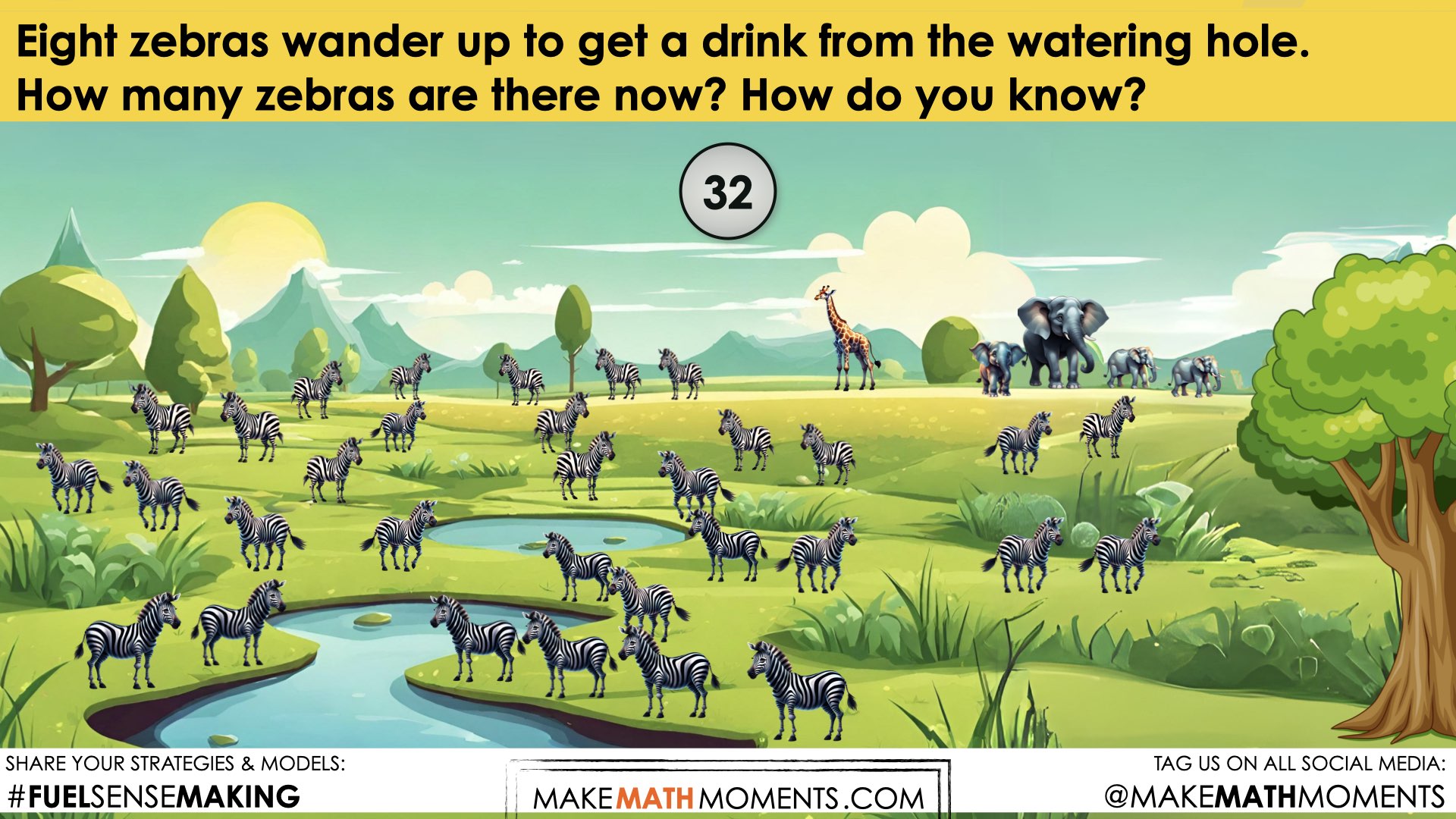
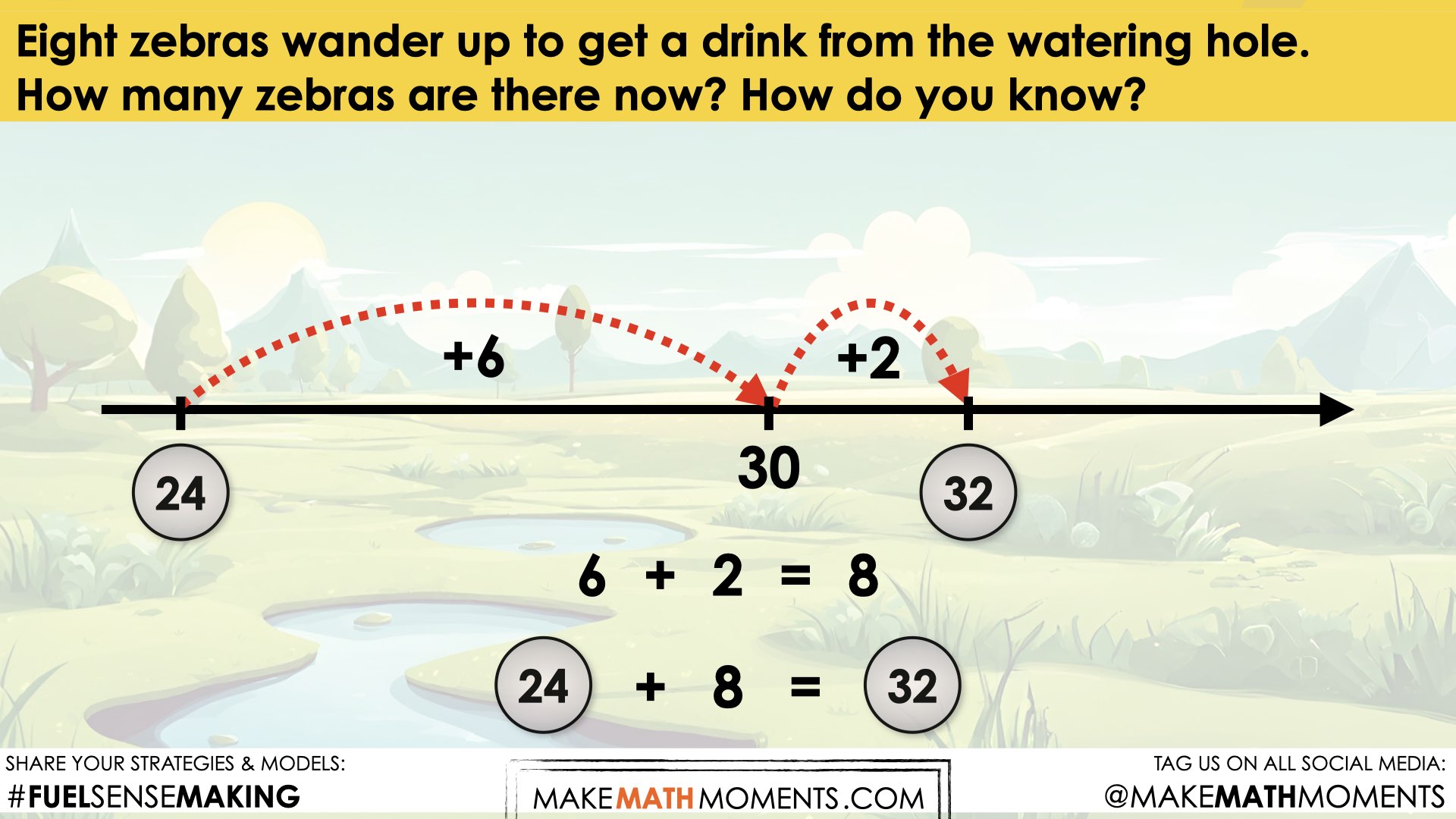 Facilitator Note:
The open number line (or empty number line) is an incredible tool for students to use to demonstrate their thinking. It allows flexibility from the traditional number line because students do not have to count the “ticks’ or “spaces”, instead they may jot their thinking anywhere on the line.
Facilitator Note:
The open number line (or empty number line) is an incredible tool for students to use to demonstrate their thinking. It allows flexibility from the traditional number line because students do not have to count the “ticks’ or “spaces”, instead they may jot their thinking anywhere on the line. Consolidation
Consolidate learning by facilitating a student discussion.
The goal of the consolidation is to demonstrate the flexible way that 8 could have been decomposed in order to make addition easier. Students that were counting on often “get lost” as they have to travel over a decade number especially if they are keeping track of the count on their fingers. As the numbers get higher or the count becomes larger, counting is not always as reliable. There are too many pieces for a student to keep track of.
We want students to start feeling more comfortable with adding numbers in a way that makes sense to them rather than just counting.
The original struggle prompt video can be revisited to show how the zebras were purposefully appearing on the screen in a 6 + 2 pattern to make up the 8 more zebras.
24 + 6 = 30 then 30 + 2 = 32
During the discussion, encourage students to start by showing their work without an explanation. Classmates will use this time to understand the visual and make their own assumptions about the work in front of them. It is also an option to ask students “What do you think this group did to solve this question?”. This will engage students in the work. The group can clarify any misunderstandings.
Reflect and Consolidation Prompts
After the reveal, check back to your estimations. The purpose here is to reflect on student reasoning, not on celebrating who was closest.
Were there some estimates in the right neighborhood?
What helped those students to get close?
Consider the strategies that the students used. Perhaps a review of counting up over the decade is necessary. The strategy of breaking up (decomposing) the addend depends on students’ flexibility with decomposing numbers. It also relies on students applying the facts of ten to other decades, in this case adding to 30. Further review through number talks or games that work with the facts of ten and extending that understanding to other decades may be helpful (e.g., 23 + 7, 67 + 3, etc).
Provide students an opportunity to reflect on their learning by offering these consolidation prompts.
Consolidation Prompt #1:
Why is it helpful to break apart/decompose 8 into 6 and 2 in this question, rather than 4 and 4?
Consolidation Prompt #2:
If you were trying to add 9 to 26, how should 9 be decomposed? What about 15 + 7?
Show your thinking on a numberline.
We suggest collecting this reflection as an additional opportunity to engage in the formative assessment process to inform next steps for individual students as well as how the whole class will proceed.
Resources & Downloads
Printable Lesson Plan PDF
Videos, Images & Media Files
Apple Keynote Presentation
Powerpoint Presentation
Printable Consolidation Prompts
Educator Discussion Area
Login/Join to access the entire Teacher Guide, downloadable slide decks and printable handouts for this lesson and all problem based units.
Explore Our 60+ Problem Based Units
This Make Math Moments Lesson was designed to spark curiosity for a multi-day unit of study with built in purposeful practice, number talks and extensions to elicit and emerge strategies and mathematical models.
Dig into our other units of study and view by concept continuum, grade or topic!



